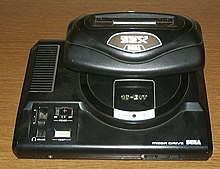Sega 32X
| Mega Drive 32Xs | ||||
|---|---|---|---|---|
| Manufacturer | Sega | |||
| Type | stationary game console | |||
| generation | 4th generation of consoles | |||
| publication |
|
|||
| Main processor | 2 × SH-2 @ 23 MHz | |||
| Storage media | Modules , with the mega-CD also CD-ROMs | |||
| successor | Sega Saturn | |||
| info | Hardware extension for the Sega Mega Drive | |||
The 32X ( Japanese ス ー パ ー 32X Sūpā 32X ) from Sega is a hardware extension for the Sega Mega Drive video game console, first presented in 1994 , which was supposed to turn the 16-bit device into a 32-bit device. Since the development resembled a blast, in which little was invested in marketing and the (technically superior) "Next Generation" consoles PlayStation from Sony and the Saturn from in-house at the end of 1994 were already in the starting blocks and were already being sold in Japan at the same time, the 32X became one of Sega's biggest failures. For some video game fans, this has made the 32X a collector's item again, especially since only a few games have been released for the console.
Names and release dates
The development of the 32X (code name Mars ) took place in the USA since the beginning of 1994, where the device was sold as the Genesis 32X from November 1994 . This followed the US name of the mega drive, Genesis . In the USA, pre-orders were already 1 million pieces, but only 500,000 pieces had been produced for this market. In Japan , the console was launched as the Super 32X in December of the same year, just in time for the Christmas business . It was not until January 1995 that it was sold in Europe and Australia as the Mega Drive 32X , so the basic device was highlighted as in the USA. The original sales price in Germany was 399 DM, around 205 euros.
Due to the different names and the fact that both the combination of Mega Drive and 32X and the 32X itself were referred to as "Mega Drive 32X", nowadays often only the designation "Sega 32X" or "32X" is used for the Expansion console used.
functionality
The 32X is plugged into the module slot of the Mega Drive, its audio / video connection is connected to the 32X externally by means of a cable, and the output to the television set is from the 32X. This increases the original color number from 64 (simultaneously) to 512 of 32,768 colors, depending on the mode, 256 (1 byte, color palette ) or 32,768 (2 bytes, directly addressed) colors can be displayed simultaneously. There are also two sound channels. The storage media are modules that have the same shape in all three versions and can only be played (or blocked) by querying the region. Existing mega-drive modules can (except for the 16-bit version of Virtua Racing , which contains an SVP chip) be played without any problems with an attached 32X, the data is looped through to the mega-drive via the module bus. In combination with a Sega Mega-CD or Sega CD , games on CD ( Mega-CD 32X ) were also possible. As with the Mega-CD, a separate power supply unit is required to operate the 32X on the Mega Drive.
After Sega of America realized that the market chances for the 32X were better if they could offer not only an add-on console but also a complete device, a Mega Drive with an integrated 32X was launched in 1995 under the name Neptune for US $ 200 announced. However, the device never got beyond a prototype status.
Processors
Two SH-2 processors with 23 MHz serve as main processors . The MC-68000 processor of the Mega Drive, clocked at 7.61 MHz, is used as a coprocessor for booting, for querying the controller and also for executing existing 68k code. Furthermore, the Z80 clocked at 3.58 MHz can still be used as a sound processor. In some conversions from the Mega Drive to the 32X, these two processors continue to do the main work, in some cases only a slight optical improvement has been made.
Published games
Games published on CD-ROM can only be used in conjunction with the Sega Mega-CD .
- 36 Great Holes Starring Fred Couples
- After burner
- BC Racers
- Blackthorne
- Brutal Unleashed: Above the Claw
- Corpse Killer (CD)
- Cosmic Carnage
- Darxide
- Doom
- FIFA Soccer 96
- Fahrenheit (CD)
- Knuckles' Chaotix
- humming-bird
- Metal head
- Mortal Kombat II
- Motocross Championship
- NBA Jam Tournament Edition
- NFL Quarterback Club
- Night Trap (CD)
- Pitfall: The Mayan Adventure
- Primal rage
- RBI Baseball '95
- Shadow Squadron
- Slam City (CD)
- Space Harrier
- Spider-Man: Web of Fire
- Star Trek: Starfleet Academy
- Star Wars Arcade
- Supreme Warrior (CD)
- T-Mek
- tempo
- Toughman Contest
- Virtua Fighter
- Virtua Racing Deluxe
- World Series Baseball
- WWF RAW
- WWF WrestleMania: The Arcade Game
- Zaxxon ’s MotherBase 2000
Web links
- Official information pages of Sega of Japan ( Memento of October 5, 2008 in the Internet Archive ) (Japanese)
- The 32X Memorial ( Memento of October 27, 2009 in the Internet Archive )

